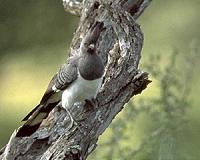| . |  |
. |
Sydney (AFP) Oct 6, 2010 Scientists Wednesday unveiled a spectacular array of more than 200 new species discovered in the Pacific islands of Papua New Guinea, including a white-tailed mouse and a tiny, long-snouted frog. The survey of remote New Britain island and the Southern Highlands ranges, accessible only by a combination of small plane, dinghy, helicopter and foot, found an exciting range of new mammals, amphibians, insects and plants. "To find a completely new genus of mammal in this day and age is pretty cool," said lead researcher Steve Richards of the new mouse species discovery. "I mean, people have heard of birds of paradise and tree-climbing kangaroos and stuff, but when you look even closer at the small things you just realise that there's a staggering diversity out there that we really know nothing about," he told AFP. Papua New Guinea's jungles are one of just three wild rainforest areas, along with the Amazon and the Congo basin, left in the world and Richards said they were a vast "storehouse" of biodiversity, with scores of new species found by his Conservation International team. The "very, very beautiful mouse", the two-centimetre (0.8 inch) long-snouted frog and another with bright yellow spots were among the highlights, but the expedition documented 100 new species in each of the spider and insect orders alone, he said. "I would say that pretty much no matter where you go in New Guinea you're guaranteed to pick up new or poorly known spectacular species," said Richards, an expert in frogs and reptiles who is based in Cairns, Australia. "For some lesser known groups only half of the things that we document actually have names, we aren't even a fraction of the way there," he added. The rugged, mountainous and largely inaccessible terrain meant biologists had not even been able to enter some regions and Richards said there were "large areas of New Guinea that are pretty much unexplored biologically". Sample animals were taken of a number of species, including the mouse, and genetic testing had confirmed that it was not related to any known creature, he said. "These kind of discoveries are almost kind of a good news story amongst all the gloom," he said, referring to the creeping extinction of other creatures. "There really are spectacular species still out there and there really is a potential for things to survive."
Share This Article With Planet Earth
Related Links Darwin Today At TerraDaily.com
 Climate Change Forcing Move Or Lose Approach To Conservation
Climate Change Forcing Move Or Lose Approach To ConservationTempe AZ (SPX) Oct 06, 2010 What does it take to save a species in the 21st century? The specter of climate change, with predicted losses to biodiversity as high as 35 percent, has some scientists and managers considering taking their conservation strategies on the road. Managed relocation (MR) is literally the physical relocation of endangered or threatened species of plants and animals, by humans, to new, and forei ... read more |
|
| The content herein, unless otherwise known to be public domain, are Copyright 1995-2010 - SpaceDaily. AFP and UPI Wire Stories are copyright Agence France-Presse and United Press International. ESA Portal Reports are copyright European Space Agency. All NASA sourced material is public domain. Additional copyrights may apply in whole or part to other bona fide parties. Advertising does not imply endorsement,agreement or approval of any opinions, statements or information provided by SpaceDaily on any Web page published or hosted by SpaceDaily. Privacy Statement |